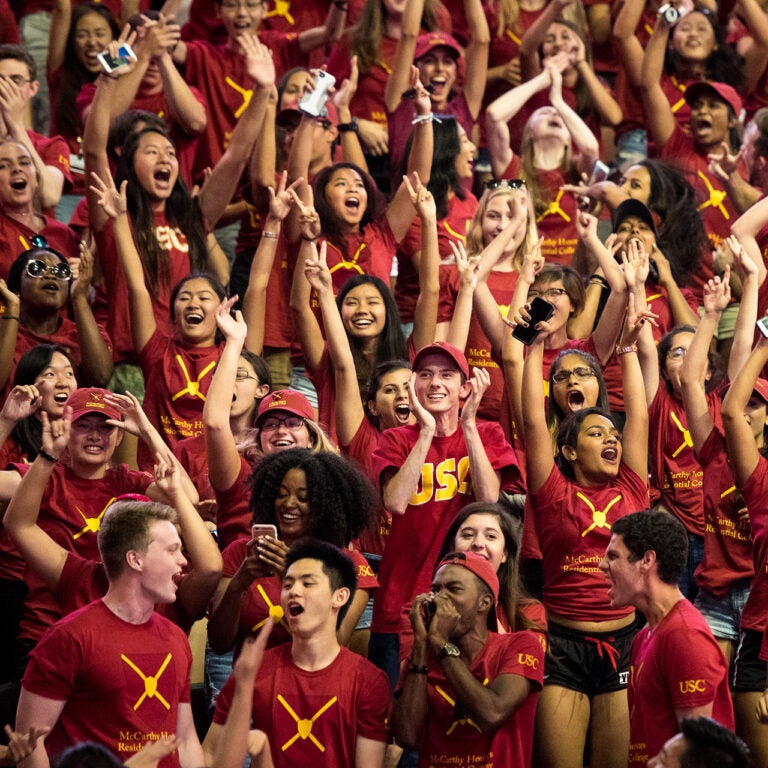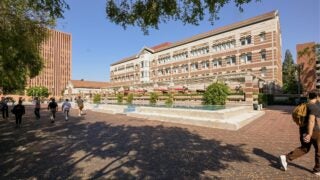USC Annenberg Dean Willow Bay, left, and Jane Fonda, center, are introduced by Allison Agsten, director of USC Annenberg’s Center for Climate Journalism and Communication. (USC Photo/Alan Mittelstaedt)
Social Impact
Jane Fonda brings her story of climate activism to USC
EARTH MONTH: The two-time Oscar winner inspired students during a wide-ranging conversation with USC Annenberg Dean Willow Bay.
Jane Fonda knew that the best way to draw in a standing room only audience to discuss climate change was by telling stories and speaking from the heart.

“This is what I want to spend the rest of my life doing: talking to young people like you all because you can make the difference,” Fonda said to the crowd of mostly students gathered inside the Wallis Annenberg Hall Forum on Thursday afternoon.
Fonda peppered in anecdotes about her work as a climate activist throughout an engaging 70-minute conversation with Willow Bay, dean of the USC Annenberg School for Communication and Journalism. The actress and activist was the star attraction at the USC Annenberg Center for Climate Journalism and Communication “Temperature Check” event that drew a crowd of about 200 people.
“You have a profound ability to bring people together,” Bay said to Fonda. “We are so fortunate to have you here today, and even more fortunate to have you as our climate champion.”

Fonda’s appearance was followed by a panel discussion on key environmental issues in Los Angeles and beyond moderated by Los Angeles Times reporter Faith Pinho and featuring Times climate columnist Sammy Roth and Director Allison Agsten of USC Annenberg’s Center for Climate Journalism and Communication. Panelists shared with attendees the kinds of stories they are currently following most closely and offered tips for communicating about the changing climate.
“One great thing about programs like this with big audiences is we have the opportunity to introduce people to Annenberg who maybe have never even been in the building before,” Agsten said as she welcomed the crowd.
A climate activist is born
Fonda shared that it was during Labor Day weekend more than five years ago that she got an unexpected delivery at her home just as she about to leave for a trip to Big Sur with fellow actresses Catherine Keener and Rosanna Arquette. It was a manuscript of Naomi Klein’s book On Fire: The (Burning) Case for a Green New Deal, which explained how bold action could avert a climate catastrophe.
Fonda, already feeling depressed about wildfires in the United States, read the book during the drive up the California coast. Upon arrival in Big Sur, she got out of the car ready for action. With little cellphone reception, she still managed to connect with Annie Leonard, then head of Greenpeace USA, and immediately began working as a climate activist.
“I felt like a lightning bolt had hit me in the stomach,” Fonda said. “It was the right moment. I needed to be told what to do.”
In partnership with Greenpeace, the Fire Drill Fridays rallies that Fonda began holding in Washington, D.C., in 2019 are part of a national movement to protest government inaction on climate change. In 2020, she authored the book What Can I Do? My Path from Climate Despair to Action and two years later launched the Jane Fonda Climate PAC focused on defeating political allies of the fossil fuel industry.
“I turned 82 in jail,” Fonda said when talking about the rallies. “What was so great is that most of the people that came had never been to a rally before and never gotten arrested before.”

Fonda has remained busy as an actress, with such recent films as Book Club: The Next Chapter and 80 for Brady as well as the long-running Netflix comedy Grace and Frankie,which ended its seven-season run in 2022. But climate activism is now her biggest priority.
“I’m sorry that we’ve created this issue for you,” Fonda said to the crowd. “But we can overcome it if we work fast and create awareness.”
Spreading the word through storytelling
Fonda came to the event armed with information that she was eager to share, including that almost 70% of Americans are concerned about the climate.
“We have to change people,” she said. “The climate crisis is a manifestation of racism, misogyny and patriarchy. It’s a mindset. When we confront the fossil fuel industry, we have to work on our mindsets.”
However, the two-time Oscar winner stressed that the way to change mindsets is not through giving facts, but in how you communicate and interact with people.
“It’s how you make them feel,” Fonda said. “Stories are the best way to make people feel furious, sad, angry, whatever.”
She mentioned some of the films she produced that had a message delivered through different genres of storytelling: the comedy 9 to 5 about female office workers, the thriller The China Syndrome about a nuclear power plant disaster, and the Vietnam War drama Coming Home, which won Fonda her second Academy Award for Best Actress in a Leading Role.
Fonda said her 4-year-old grandson gives her “plenty of reason to want to fight like hell” when it comes to the climate.
“If we started doing everything right now, in 25 or 30 years, the climate issue would be on its way out,” she said. “By the time he’s 25, things would be OK. That motivates me.”
Students react to Jane Fonda at USC
USC Dornsife College of Letters, Arts and Sciences senior Sparsh Sharma did some research before the event to learn more about Fonda’s work as a climate activist.
“Her comments about storytelling were illuminating,” Sharma said. “It was great to be here and to listen to her speak and to see what climate activism actually looks like in person.”
USC Annenberg senior Juliet Lippman came to the event as an admirer of Fonda the actress — especially her Academy Award-winning performance in Klute and the “iconic” 9 to 5.
“I came here as a fan, but I am leaving thinking about these issues,” Lippman said. “She brings so much life to the subject and makes you feel like you can individually do something. I feel very empowered after this conversation with her.”
USC Dornsife senior Isabella O’Brien had two words to describe the session with Fonda: “Really fantastic.”
“It’s really incredible to me just how much she knows about the climate movement, all the different organizations, the history,” O’Brien said. “Obviously, there’s a large generational gap between her and many of the students, but she got a lot of laughs, a lot of smiles and a lot of cheers.”



